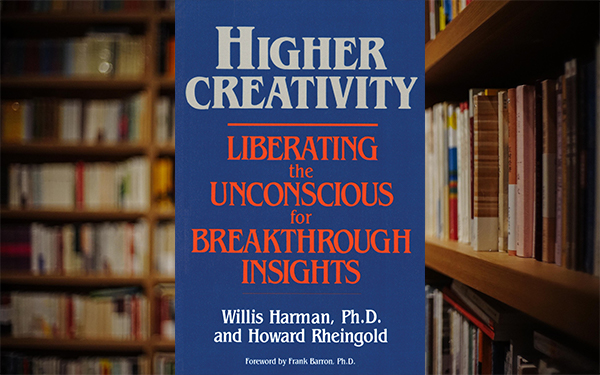Please enjoy this except from the book Higher Creativity: Liberating the Unconscious for Breakthrough Insights written by IONS past president Willis Harman and Howard Rheingold.
The most ordinary and the most extraordinary manifestations of our minds are not entirely unrelated phenomena, but rather the extreme ends of a continuum of creative consciousness.
At the “low” end of this spectrum, the phenomena are so much an accepted part of everyday life that most of us never stop to think about the mysterious power behind some of our most ordinary mental activities. For example, you are asleep, and although an assortment of familiar city noises occur during the night, you continue to sleep peacefully. Then you are jolted awake by one quiet sound that doesn’t fit—perhaps it is the squeaking hinge of a door that normally remains shut. You sit up in bed, feeling slightly alarmed, but you aren’t entirely sure why you are alarmed until the door squeaks again and your conscious sense of hearing tunes in to it. You get up, close the door, and return to bed. Within seconds, you fall asleep.
The mystery begins when you start to wonder why that particular sound happened to register in your consciousness while the much louder sound of the bus that passes under your window every half hour never wakes you. What is the “other part of your mind” that watches over you and remains conscious of the environment even when ordinary consciousness is extinguished in sleep?
Now consider another kind of experience, one that might at first appear to be in a wholly different dimension from the squeaky door. There is a certain state of heightened awareness, an experience of intense “breakthrough” insight that, although it is a less common occurrence, happens to us all at one time or another. It is a state in which the floodgates of thought seem suddenly thrown open and profound ideas and images, often solutions to our deepest problems—questions about life, our work, or our relation to the universe around us—are revealed in an instant. Our language offers a choice of words to describe such moments of unusual awareness—words like premonition, inspiration, intuition, and illumination. We treat these extraordinary moments with varying degrees of credibility, depending on what we believe to be possible—which in turn depends on what our society taught us ought to be possible (or at least what it thinks ought to be possible).
The great creative thinkers and originators of our society have almost invariably experienced this kind of “breakthrough” state in the course of producing their most valuable scientific theories, their most acclaimed works, their most revolutionary social or religious insights. In these cases, the hidden part of the mind didn’t lead to a squeaky door hinge but to a new idea powerful enough to enrich humankind or alter the course of history.
Might the sound of the squeaky hinge that wakes you in the middle of the night, and the melody that floods into the mind of the composer, be more closely related than we have heretofore thought?
Are these kinds of talents and abilities possessed only by the few lucky enough to have been “gifted” with them? And if so, are they the result of chance mutation or inherited genes?
Or are they, instead, innate capacities we all possess and lack only the knowledge or training necessary to make proper use of them—capacities others have learned to use before and which we can learn to use ourselves?
Perhaps what we call genius has something to do with a learned state of consciousness, a way of attending to the stream of mental experience. Perhaps many more of us could hear inner melodies, find guidance and inspiration, achieve breakthrough insight—if we could only pay more attention to the fleeting images and the quiet intuitions presented to us by the creative mind.
Willis Harman was invited by astronaut Edgar Mitchell to join the Institute of Noetic Sciences (IONS) in 1973, the year it was founded. He went on to serve as its president from 1978 until his death in 1997. He described IONS’ mission as bringing science and religion back together, though in ways that would require fundamental changes in both.
